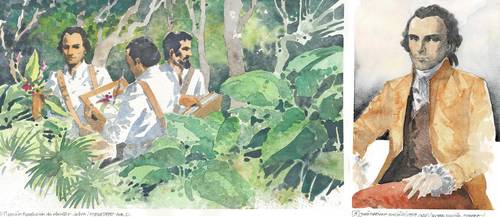The contributions of José Mariano Mucino from more than 200 years ago are valid for the study of biodiversity

▲ Illustrations of the natural world are taken from p Bicentennial Magazine And courtesy of the Royal Botanic Garden.
Erent Gomez
La Jornada newspaper
Tuesday, May 28, 2024, p. 6
José Mariano Muceno, a scientist of the Viceroyalty who rose to prominence for his contributions to botany, zoology and ethnography, is remembered by the community of biologists, naturalists and ornithologists, on the 95th anniversary of the Institute of Biology (IB) of the National Autonomous University of Mexico (UNAM).
During the tribute entitled José Mariano Mucino: naturalist and explorer. Held in the IB Hall, the specialists highlighted the work of the botanist on the Royal Botanical Expedition to New Spain (1787-1803), directed by Martin de Sisi, to investigate and document the flora and fauna of that region. They noted that this was a taxonomic achievement that remains valid to this day.
José Luis Godinez Ortega, Doctor of Marine Sciences from the Center for Advanced Research and Studies of the National Polytechnic Institute and one of the coordinators of the 14 volumes on that expedition, In which an effort was made to link illustrations to texts, he said: The collection derived from Mociño’s work is a valuable, must-see contribution to botanical, zoological, linguistic and historical studies on Mexico’s biodiversity and the information associated with that journey. Collecting all the information: manuscripts, publications, herbaria and illustrations, will allow the current botanist to make new considerations about Mexican plants.
.
He added that There were 1,830 leaves, the product of expeditions undertaken by Mousinho, Ceci and other collaborators; Analyzed by the Institutes of Biology and Philosophical Research of UNAM, it was determined that there are 165 families, 796 genera and 1,326 species.
.
The algae specialist and researcher at the National Herbarium explained that each element of these papers has been identified and organized in a modern system, so that botanists can benefit from them more. In addition, the locations that Mociño’s expedition passed through have been geographically mapped.
The researcher concluded that of the 1,830 paintings, we could only make 540 of them consistent with the descriptions, 1,073 without an explanation, and there were 154 duplicate paintings and 63 botanical observations.
Graciela Zamudio Varela, a professor of biological sciences whose research focuses on natural history knowledge in New Spain-period Mexico, highlighted Mociño’s contribution to the natural history of fauna and his special interest in birds.
He discovered the manuscript while researching in Europe Theses on the birds of New Spain, de Mucino, in the National Museum of Natural Sciences in Madrid, which allowed the creation of the thirteenth volume of the collection.
We were aware of publications on the herpetological and entomological aspects of the expedition, but little was known about the ornithological part, despite the fact that in some archives Mucino speaks of sending birds to Spain.
Detained.
Zamudio Varela emphasized that the discovery of the manuscript made it possible to learn about this hobby of the naturalist. He considered his work to be a current reference for those interested in environmental history.
Diplomatic skills
Juan Esteban Martinez Gómez, a researcher at the AC Institute for the Environment of the National Council for the Humanities, Sciences and Technology, noted that during the excavation of Nootka, in the northwest of the American continent and at that time the subject of a dispute for being a strategic location for navigation, Mucino showed his diplomatic skills.
He explained that thanks to the botanist’s dialogue with the representatives who disputed ownership of the island and his work as a translator, the exploration was possible, allowing many fish species to be documented.
Martinez Gomez, who has studied birds in Los Tuxtlas, Veracruz, said the scientist’s work in that area would prepare him to explore areas further south on the continent.
He confirmed: Mociño’s work is a window through time. It allows us to think about the fragility of biodiversity. There are currently 185 endangered species, which were abundant locally in the time of these explorers. But we hope their studies will also inspire us to work together to conserve biodiversity.
.
During the tribute, the short film was shown José Mariano Mousinho, The Amazement of the New World, Made by Felipe Parra Samano, who commented that the purpose of this document is Showing the enormous dimension of what was proposed when he had in mind the publication of a work on Mexican flora and fauna and the world-historical context in which he found himself at the time of participation in the Royal Botanical Expedition…
.

“Creator. Devoted pop culture specialist. Certified web fanatic. Unapologetic coffee lover.”
